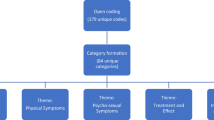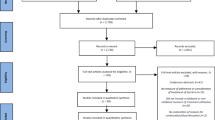Abstract
Erectile dysfunction (ED) can impair the quality of life and the relationship. An early treatment is necessary to avoid the development of comorbid complaints. To arise the help-seeking behavior and to improve the treatment of affected men, it is necessary to be aware of the treatment expectations. The objective of this study was to investigate the treatment expectations of men with ED and their female partners. This is an explorative qualitative study using semistructured telephone interviews with 12 men with ED and their female partners. Interviews were tape-recorded, transcribed and analyzed on the basis of the grounded theory. We could identify various treatment expectations, which could be differentiated into expectations according to the conditions (for example, low costs and an early access), the handling of the practitioner (for example, showing interest and taking the patient seriously or incorporate the female partner), the treatment itself (for example, clearing the causes and helpful medication) and the treatment outcome (for example, having no ED and more sexual desire). Considering the identified expectations could increase treatment motivation and compliance. We derive five theses from our data, how to implement our findings.
This is a preview of subscription content, access via your institution
Access options
Subscribe to this journal
Receive 8 print issues and online access
$259.00 per year
only $32.38 per issue
Buy this article
- Purchase on Springer Link
- Instant access to full article PDF
Prices may be subject to local taxes which are calculated during checkout

Similar content being viewed by others
References
Rosen RC, Fisher WA, Eardley I, Niederberger C, Nadel A, Sand M . The multinational men’s attitudes to life events and sexuality (MALES) study: I. Prevalence of erectile dysfunction and related health concerns in the general population. Curr Med Res Opin 2004; 20: 607–617.
Kubin M, Wagner G, Fugl-Meyer AR . Epidemiology of erectile dysfunction. Int J Impot Res 2003; 15: 63–71.
Schaefer GA, Ahlers CJ . A discussion of the differential diagnosis of the impaired erection [German]. Urologe A 2006; 45: 967–974.
Lee SK, Jeong J, Kang Y, Jang S, Choi YJ, Kim D . Relationship between erectile dysfunction and depression: an analytic cross-sectional study. Eur Urol 2007; 6: 260.
Rosen RC, Seidman SN, Menza MA, Shabsigh R, Roose SP, Tseng LJ et al. Quality of life, mood, and sexual function: a path analytic model of treatment effects in men with erectile dysfunction and depressive symptoms. Int J Impot Res 2004; 16: 334–340.
Sanchez-Cruz JJ, Cabrera-Leon A, Martin-Morales A, Fernandez A, Burgos R, Rejas J . Male erectile dysfunction and health-related quality of life. Eur Urol 2003; 44: 245–253.
Beutel ME, Schumacher J, Weidner W, Brahler E . Sexual activity, sexual and partnership satisfaction in ageing men—results from a German representative community study. Andrologia 2002; 34: 22–28.
Metz ME, Epstein N . Assessing the role of relationship conflict in sexual dysfunction. J Sex Marital Ther 2002; 28: 139–164.
Abolfotouh MA, Helali NS . Effect of erectile dysfunction on quality of life. East Mediterr Health J 2001; 7: 510–518.
Shabsigh R, Zakaria L, Anastasiadis AG, Seidman AS . Sexual dysfunction and depression: etiology, prevalence, and treatment. Curr Urol Rep 2001; 2: 463–467.
Melnik T, Abdo CH . Psychogenic erectile dysfunction: comparative study of three therapeutic approaches. J Sex Marital Ther 2005; 31: 243–255.
Günzler C, Berner MM . Efficacy of psychosocial interventions in men and women with sexual dysfunctions: a systematic review of controlled clinical trials. J Sex Med 2012; 9: 3108–3125.
Mulhall J, Althof S, Brock GB, Goldstein I, Jänemann K, Kirby M . Erectile dysfunction: monitoring response to treatment in clinical practice-recommendations of an international study panel. J Sex Med 2007; 4: 448–464.
McCabe MP, Price E, Piterman L, Lording D . Evaluation of an internet-based psychological intervention for the treatment of erectile dysfunction. Int J Imp Res 2008; 20: 324–330.
Wespes E, Eardley I, Giuliano F, Hatzichristou D, Hatzimouratidis K, Moncada I et al Guidelines on male sexual dysfunction: erectile dysfunction and premature ejaculation, 2013, available at: http://www.uroweb.org/gls/pdf/14_Male%20Sexual%20Dysfunction_LR.pdf.
Althof SE, O'Leary MP, Cappelleri JC, Hvidsten K, Stecher VJ, Glina S et al. Sildenafil citrate improves self-esteem, confidence, and relationships in men with erectile dysfunction: results from an international, multi-center, double-blind, placebo-controlled trial. J Sex Med 2006; 3: 521–529.
Montorsi F, Padma-Nathan H, Glina S . Erectile function and assessments of erection hardness correlate positively with measures of emotional well-being, sexual satisfaction, and treatment satisfaction in men with erectile dysfunction treated with sildenafil citrate (Viagra). Urology 2006; 68: 26–37.
Müller MJ, Ruof J, Graf-Morgenstern M, Porst H, Benkert O . Quality of partnership in patients with erectile dysfunction after sildenafil treatment. Pharmacopsychiatry 2001; 34: 91–95.
Anjang AB, Rahman A, Al-Sadat N, Low W . Help seeking behaviour among men with erectile dysfunction in primary care setting. Journal of Men’s Health 2011; 8: 94–96.
Moreira ED, Brock G, Glasser DB, Nicolosi A, Laumann EO, Paik A et al. Help-seeking behaviour for sexual problems: the global study of sexual attitudes and behaviors. Int J Clin Pract 2005; 59: 6–16.
Ansong KS, Lewis C, Jenkins P, Bell J . Help-seeking decisions among men with impotence. Urology 1998; 52: 834–837.
Shabsigh R, Perelman MA, Laumann EO, Lockhart DC . Drivers and barriers to seeking treatment for erectile dysfunction: a comparison of six countries. BJU Int 2004; 94: 1055–1065.
Claes H, Opsomer RJ, Vanderdonck F, Andrianne R . Characteristics of patients discussing erectile dysfunction with a physician in Belgium: results from the S.C.O.R.E.D. study. Eur Urol 2007; 6: 260.
Marwick C . Survey says patients expect little physician help on sex. JAMA 1999; 281: 2173–2174.
Fisher WA, Meryn S, Sand M the Strike Up a Conversation Study Team. Communication about erectile dysfunction among men with ED, partners of men with ED, and physicians the Strike Up a Conversation study (Part II). J Mens Health Gend 2005; 2: 309.
Fisher WA, Meryn S, Sand M, Brandenburg U, Buvat J, Mendive J et al. Communication about erectile dysfunction among men with ED, partners of men with ED, and physicians: The Strike Up a Conversation Study (Part I). J Mens Health Gend 2005; 2: 64–78.
Hatzimouratidis K, Hatzichristou DG . A comparative review of the options for treatment of erectile dysfunction: which treatment for which patient? Drugs 2005; 65: 1621–1650.
Lue TF, Giuliano F, Montorsi F, Rosen RC, Andersson KE, Althof S et al. Summary of the recommendations on sexual dysfunctions in men. J Sex Med 2004; 1: 6–23.
Hanson-Divers C, Jackson S, Lue T, Crawford S, Rosen RC . Health outcomes variables important to patients in the treatment of erectile dysfunction. J Urol 1998; 159: 1541–1547.
Perimenis P, Roumeguere T, Heidler H, Roos E, Belger M, Schmitt H . Evaluation of patient expectations and treatment satisfaction after 1-year tadalafil therapy for erectile dysfunction: the DETECT study. J Sex Med 2009; 6: 257–267.
Claes H, Opsomer RJ, Andrianne R, Vanbelle S, Albert A, Vanderdonck F . Characteristics and expectations of patients with erectile dysfunction: results of the SCORED study. Int J Impot Res 2008; 20: 418–424.
Chartier-Kastler E, Amar E, Chevallier M, Montaigne O, Coulange C, Joubert JM et al. Does management of erectile dysfunction after radical prostatectomy meet patients’ expectations? Results of a national survey (REPAIR) by the French Urological Association. J Sex Med 2008; 5: 693–704.
Riley A ., The role of the partner in erectile dysfunction and its treatment. Int J Impot Res 2002; 14: 105–109.
Riley A . When treating erectile dysfunction, do not forget the partner. Int J Clin Pract 2008; 62: 6–8.
Glaser BG, Strauss AL . The Discovery of Grounded Theory. Strategies for Qualitative Research. Aldine Publications: Chicago, IL, USA, 1967.
Strauss AL . Qualitative Analysis for Social Scientists [German]. Fink: München: München, 1998.
Flick U . [Psychologie Des Technisierten Alltags.]. Verlag für Sozialwissenschaften: Opladen: Opladen, 1996.
Flick U . Qualitative Social Research [German]. Rowohlt: Hamburg, Germany: Hamburg, Germany, 2012.
Muhr T . ATLAS.ti The Knowledge Workbench. Berlin, Germany, 2004; available at www.atlasti.com.
Hackett G . What do patients expect from Erectile Dysfunction Therapy? European Urology Supplements 2002; 1: 4–11.
Berner MM . A typology of men’s sexual attitudes, erectile dysfunction treatment expectations and barriers. Int J Impot Res 2007; 19: 568–576.
Dean J, Rubio-Aurioles E, McCabe M, Eardley I, Speakman M, Buvat J et al. Integrating partners into erectile dysfunction treatment: improving the sexual experience for the couple. Int J Clin Pract 2008; 62: 127–133.
Fisher WA, Eardley I, McCabe M, Sand M . Erectile dysfunction (ED) is a shared sexual concern of couples I: couple conceptions of ED. J Sex Med 2009; 60: 2746–2760.
Kelly MP, Strassberg DS, Turner CM . Communication and associated relationship issues in female anorgasmia. J Sex Marital Ther 2004; 30: 263–276.
Kelly MP, Strassberg DS, Turner CM . Behavioral assessment of couples’ communication in female orgasmic disorder. J Sex Marital Ther 2006; 32: 81–95.
Corona G, Petrone L, Mannucci E, Ricca V, Balercia G, Giommi R et al. The impotent couple: low desire. Int J Androl 2005; 28: 46–52.
Ehrensaft MK, Condra M, Morales A, Heaton J . Communication patterns in patients with erectile dysfunction and their partners. Int J Impot Res 1994; 6: 25–32.
Günzler C, Kriston L, Stodden V, Leiber C, Berner MM . Can written information material help to increase treatment motivation in patients with erectile dysfunction? A survey of 1188 men. Int J Impot Res 2007; 19: 330–335.
Berner MM, Leiber C, Kriston L, Stodden V, Günzler C . Effects of written information material on help-seeking behavior in patients with erectile dysfunction: a longitudinal study. J Sex Med 2008; 5: 436–447.
Steinke I Criteria of qualitative research In: Flick U, Kardoff E, Steinke I (eds) Qualitative Research—a Handbook [German]. Rowohlt: Reinbek, 2000 pp 319–333.
Acknowledgements
This study was supported by an unrestricted grant from Pfizer, Germany.
Author information
Authors and Affiliations
Corresponding author
Ethics declarations
Competing interests
The authors declare no conflict of interest.
Additional information
Supplementary Information accompanies the paper on International Journal of Impotence Research website
Supplementary information
Rights and permissions
About this article
Cite this article
Henninger, S., Höhn, C., Leiber, C. et al. Treatment expectations of men with ED and their female partners: an exploratory qualitative study based on grounded theory. Int J Impot Res 27, 167–172 (2015). https://doi.org/10.1038/ijir.2015.9
Received:
Revised:
Accepted:
Published:
Issue Date:
DOI: https://doi.org/10.1038/ijir.2015.9



